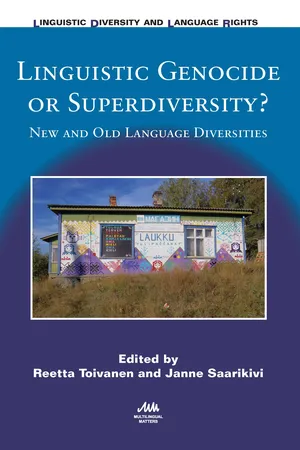![]()
Part 1
Language Communities or Networks of Communication? Old and New Linguistic Diversity
![]()
1Fragmentation of the Karelian Language and Its Community: Growing Variation at the Threshold of Language Shift
Niko Partanen and Janne Saarikivi
This chapter discusses language shift, attrition and variation as related features of a community undergoing rapid cultural change, including ethnic and linguistic assimilation. We focus on Karelian, an endangered Finnic minority language relatively closely related to Finnish, from the perspectives of language attitudes, ethnic identities, language shift, social networks, linguistic variation and language change. It is our aim to demonstrate that in a speech community undergoing fragmentation, many linguistic processes occur, such as intensive borrowing, code-switching, copying of codes and emergence of new structures that enhance the linguistic variation. Thus, contrary to the idea of linguistic purism and laypeople’s language attrition discourse, a language under serious threat of disappearance is often richer in variation than a stable language. Much of the new variation differs from the traditional variation, though, and is based on language switching and mixing, as well as intensive borrowings from different types of available linguistic codes.
Research Aims
In the following, language use in the Karelian village of Tuuksa is investigated from the points of view of language attitudes, ethnic stereotypes, social networks, linguistic variation and, ultimately, language shift and language change. It is our aim to investigate language shift and language change as related phenomena guided by the fragmentation of a minority language community. Instead of attempting to estimate the extent of language shift, we want to explore the processes that have led to the current situation and continue to maintain it (cf. Grenoble, 2011: 38).
The process we are focusing on has been noted also by Don Kulick and Susan Gal, for example, namely that language shift is deeply connected to the ways in which individuals come to interpret the languages, their speakers, and particularly, one another (Kulick, 1992: 9). It is possible to distinguish individual contributing factors to language shift such as urbanisation, modernisation or school. The challenge, however, is to explain how these factors have acquired the significance that eventually changes speech practices on a local and individual level. Gal (1979: 3) emphasises that ‘the process of language shift should be seen within a broader framework of expressively and symbolically used linguistic variation’. In a still broader framework, Schiffmann (1996) writes about linguistic culture, which he defines as a social construct based on language attitudes and myths guiding the linguistic behaviour of people. Linguistic culture is thus made up of ideas related to the appropriate use of languages by different people in different situations, the expected linguistic behaviour and the value of different types of speech. This study is taking the first steps in studying language shift involving Uralic languages spoken in Russia from this perspective by investigating the language change and shift in connection with the changing social reality that interacts with widespread ideas about Karelian and Russian speakers and their origins, age, livelihoods and appearance.
For this purpose, we first investigate the language shift from Karelian to Russian in Tuuksa, from the perspectives of intergenerational transmission and language use in different domains. We then continue by demonstrating that the present Karelian-speaking community shows strong ambiguity regarding the identification of Karelian speakers. In the community under investigation, practically everyone can speak Russian, but people are much less aware of who is able to speak Karelian. In circumstances where community life is no longer conducted in Karelian, a fragmentation of the speech community is taking place. It is no longer clear with whom one can speak Karelian, and the language is thus becoming increasingly associated with family relations and the closest social environment of an individual. This feature of a community undergoing language shift causes the split of a Karelian speech community into multiple social networks, and thus creates the conditions for accelerated language change: increased variation and diversity. Simultaneously, family relations guarantee the intergenerational transmission of some local cultural knowledge transcending the language shift and make it possible for a certain integrity of the community to prevail.
In the diminishing speech community, multiple new ways of speaking Karelian have emerged. The main sources for innovations in the new forms of spoken Karelian are borrowings from Russian and code-mixing with Russian dialects and literary language, as well as the influence of Finnish, the closest language form to Karelian with a full-fledged written standard (cf. also Edygarova [2015] on a somewhat similar situation in connection with the Udmurt language). Further, several abrupt attempts to create a Karelian literary language have caused confusion in the speech community regarding the right ways to speak Karelian. This state of affairs, emerging in the context of the puristic linguistic culture of Russia (cf. Edygarova in this volume) and the fact that the Karelians do not have opportunities to learn to master the standard in their mother tongue through schooling and media, is having an effect on the situation of Karelian (cf. Pischlöger in this volume).
Thus, there is often more variation in a language-shifting community – in the form of code-switching, intertwined and mixed codes – than in a stable, ‘primordial’ speech community where the variation is predominantly areal, social and situational. Such increased variation can be viewed as new types of ‘languaging’ or plurilingualism (cf. Blommaert & Rampton, 2011), but it is often also a symptom of an ongoing language shift among the minority language speakers. In communities such as Karelian villages, the new variation is likely to be short-lived and be replaced by relatively uniform majority language use. It is thus not easy to assess such linguistic variation in an endangered language community from the point of view of linguistic diversity; on the one ha...
